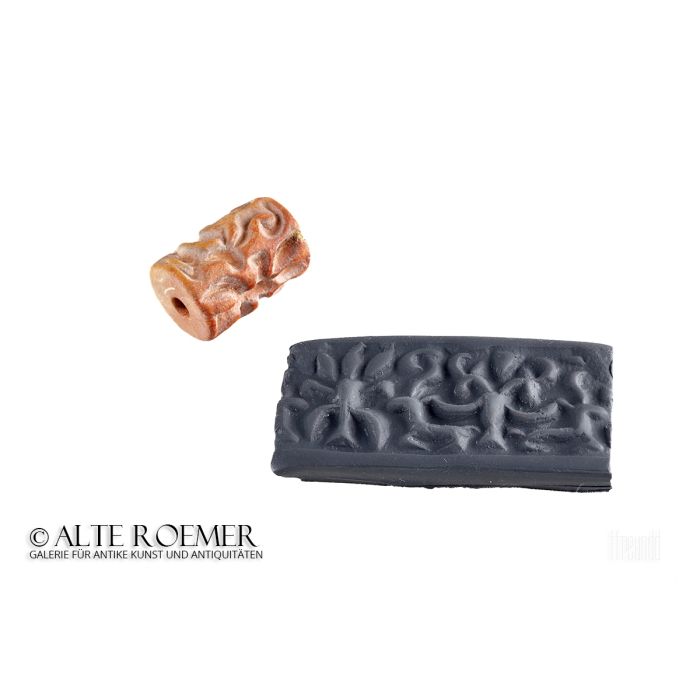Rare iranian cylinder seal
Price: on request
Sold
Object number
AR2297
| Object: |
Iranian cylinder seal
|
| Material: |
Light red limestone.
|
| Period: |
2nd half of the 3rd Millennium BC.
|
| Description: |
Cylindrical seal with drill hole along the central axis. A mythological scene is carved into the mantle of the seal. The seal impression shows in the centre a bird with tail feathers down and wings spread. To both his sides is a horned animal moving away. The scene is terminated on one side by a tree. This might be a seal from the Iranian province Kerman. It was independant of its mighty neighbour the Elamites. |
| Background: |
Cylinder seals have been invented by the early civilizations of Mesopotamia. From the 4th Millenium BC onwards they conquered the whole Near East and beyond.
The emergence of this type of seal coincides with the first abundant use of scripture to manage the young highly organized city states. Such early seals are therefore a gimpse at the beginnings of civilization in Mesopotamia. Later seals broaden the view to all areas of administration, but also to trade and even personal matters. Many officials, traders and private persons must have possed cylinder seals during the Bronze Age of Mesopotamia. What a happy instance for today's historians. Cylinder seals were made of durable materials and survived the millenia nearly unchanged. A treasury of images and inscriptions is reaching out to us from the Bronze Age. Thanks to the diverse original owners many stray finds have been made in the Near and Middle East. After the interest in antiquity has been reborn in Europe such finds have been preserved and valued. Many pieces could be attended to in private and public collections. And because of academic excavations with documented find contexts a chronology could be worked out. Today, also the stray pieces on the art market and in collections can be dated by iconographic means. For us it is a very special sensation to hold such seals in our hands and reflect the rise and fall of civilizations. |
| Dimensions: |
24mm length, 16mm diameter.
|
| Condition: |
Near perfect condition. Small chips on one end, scratches on the other end. The seal area is perfectly preserved. Including imprint.
|
| Provenance: |
Acquired by us in 2017 in a British auction house. Previously in British private possession. Acquired between 1970 and 1989. In the 1980ies and while in the private collection the cylinder seal was inspected and described by Professor Lambert. A copy of his notes is available. Wilfred George Lambert (1926 to 2011), a British archeologist specialized on Western Asia, was a professor at the University of Birmingham. After his retirement he was active in the ancient near eastern department of the British Museum. |
| Authenticity: |
We guarantee the authenticity of this object and all works of ancient art sold by us for life.
|


